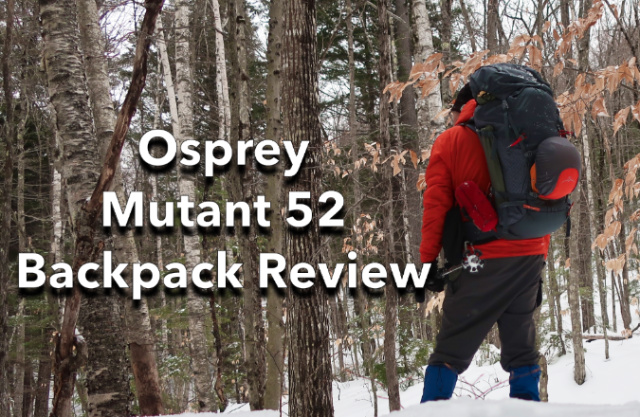
The Osprey Mutant 52 is a winter backpack suitable for four-season overnight hiking, climbing, or backcountry ski trips. It’s the big brother to the Osprey Mutant 38 which I reviewed at the beginning of the winter which has less volume and is oriented more towards day trips. Like its little brother, the Mutant 52 is loaded with all of the features of a specialized winter backpack including a variety of tool holders, haul loops, ski straps, daisy chains, compression straps, and glove-friendly buckles. If you head into the backcountry frequently in winter, it really is worth your while to get a backpack optimized for winter use. It makes life so much easier when you can use the right tool for the job.
Specs at a Glance
- Type: Internal Frame (removable)
- Access: Top, Floating lid
- Pockets: 3
- Mfg Weight: (S/M: 51.6 oz/1462 g; M/L: 54.4 oz/1542 g)
- Actual tested weight: (M/L: 54.8 oz / 1544 g)
- Removable components: Top lid (5.3 oz), framesheet (7.5 oz), aluminum frame stays (3.2 oz), helmet carry net (1.6 oz)
- Load lifters: Yes
- Helmet carry net: Yes (top or front)
- 3 Point haul loops: Yes
- Reversible harness-compatible hipbelt: Yes
- Hipbelt gear loops: Yes
- Wand Pockets: 2
- Hydration compatible: Yes
- Ice tool holders: 2
- Ski carry: Reinforced A-frame straps
- Torso range: (S/M: 15-19 inches; M/L: 18-22 inches)
- Materials: Main: 210D high-tenacity recycled nylon; bottom: 450D recycled polyester
- Max recommended load: 50 lbs (according to Osprey) we think 40 lb is more realistic.
Backpack Storage and Organization
The Mutant 52 is a streamlined top-loading backpack with a floating top lid and a main compartment that closes with a drawstring. While there are wand pockets on both sides of the pack, the pack lacks side water bottle pockets or a front stuff pocket, in line with its minimalist winter character. While the lack of external storage pockets makes the pack more durable for hauling up cliffs, there is no shortage of places on the pack to attach bulky gear with sharp points. Since trail conditions can vary widely in winter, you often need to carry multiple traction or flotation options because you don’t know what you’ll encounter. Unlike a three-season backpack, you can’t store most of this gear (crampons, ice axe, snowshoes, microspikes) inside the pack because it will make everything wet and rip it to shreds.

The floating top lid is attached to the top of the pack with plastic buckles and webbing straps, making it easy to remove if it’s not needed. Floating lids are a great option on winter packs because you can sandwich bulky gear like ropes, tent bodies, or foam pads between the lid and the main compartment if you need to carry extra gear on approach hikes.
If you plan to use the Mutant 52 for backpacking, make sure you have a tent, tarp, or bivy sack that packs up small or that you can strap under the floating lid. The 52 liter volume is on the small side for a winter backpack, which makes external gear storage and the use of highly compressible gear paramount.

The top lid has two pockets. A cavernous, zippered main pocket (with a key fob) that’s big enough to store multiple pairs of gloves, hats, maps, and navigation equipment. There’s also a second smaller pocket that contains a helmet carry net with corner hooks that can be attached to the top of the lid (if used) or attached to the daisy chains on the front of the pack. This small pocket is also large enough to hold a GPS or satellite messenger, smartphone, or camera and is a handy place to stash stuff.
If you don’t need the top lid or want to reduce the weight of the pack you can remove it and save close to a half pound of gear weight. The Mutant 52 comes with a permanently attached speed lid (Osprey calls these flap jackets) that covers the hole over the main compartment if the top lid is removed and clips into the same set of straps. A rope strap can also be used to secure coils or rope or other gear on top of the flap jacket with or without the floating lid. Personally, I find a top pocket indispensable in winter for spare gloves, hats, and map storage so I prefer to keep the floating lid attached.

The main compartment has a hydration pocket inside with a hook to hang a bladder and dual hydration ports located between the shoulder pads. There’s also an internal frame pocket inside the pack with a removable frame (a plastic sheet and w/ 2 aluminum stays) which you could replace with a bivy pad, although it will reduce the pack’s load-carrying capacity.
Osprey Mutant 52
Comfort
Weight
Suspension
Features
Adjustability
Sizing
Durability
Infinitely Versatile Winter Pack
The Osprey Mutant 52 is a lightweight internal frame winter backpack optimized for climbing, backcountry skiing, and streamlined winter backpacking use. While the Mutant 52 has a superb external attachment system, the pack's frame and load-carrying capabilities are where it really shines. The combination plastic frame sheet and pair of aluminum stays make it possible to carry 40-pound loads with ease, while the minimal shoulder strap and hip belt padding make the pack highly responsive when skiing, climbing, and snowshoeing.
Compression and External Attachment Points
The Mutant 52 has two tiers of side compression webbing straps, which can also be used to secure gear to the sides of the pack. Both close with glove-compatible buckles. The bottom buckle is new on this version of the Mutant 52. The previous model didn’t have it and it makes strapping snowshoes to the sides of the pack much easier. In comparison, many three-season packs have replaced side webbing straps with cords, ostensibly to save weight, but it makes their packs much less suitable for winter use because the lineloc tensioners used to pull the side cords jam with ice, the cords absorb water and freeze, and they are unusable while wearing gloves.

There are reinforced ski loops positioned under the bottom compression strap, making it possible to configure an A-Frame ski carry together side compression straps. There are also shallow wand pockets on the pack sides that can also be used to hold tent poles in place under the compression straps.
The Mutant comes with a universal ice tool holder system, including two shaft holders. A pair of daisy chains and webbing straps on the pack’s front lets you attach a pair of crampons without a crampon bag. Alternatively, you can attach a helmet here or on the top of the floating lid which also has daisy chains available for that purpose. The Mutant’s climbing and mountaineering pedigree are also evidenced by a three-point haul system, good for winching gear up cliffs and to portaledges.

Backpack Frame and Suspension
The Mutant 52 is an internal frame backpack with a stiff plastic sheet and two removable aluminum frame stays, so you can adjust the degree of stiffness you want. The aluminum stays can also be custom-shaped to fit your body shape if desired. The pack also has load lifters, which are particularly useful on packs designed to haul heavy gear. The entire frame system is removable if you want to save gear weight. Tightly packed gear can often compensate for the lack of a frame, at least in terms of pack bag stiffness, or you can drop a foam pad into the main compartment and pack your gear inside it (like a donut) to create the same effect.

The shoulder pads, back of the pack, and hip belt wings are lightly padded with foam and provide minimal cushioning to help keep the pack weight down. The shoulder pads are minimally outfitted with two hydration hose keeper loops and an adjustable sternum strap with a daisy chain height-adjustment system. The latter is handy for attaching external pockets to the shoulder straps. Gone is the foam bivy pad in previous versions, so I like to insert a cut-down foam Zlite pad behind the shoulder straps (in the main compartment) for emergencies and to further insulate my back from the hot water bottles I carry in winter.

The hip belt comes with gear loops instead of pockets to rack gear with carabiners. It can also be folded back around the front of the pack if you’re wearing a climbing harness. The hip belt closes with a single beefy buckle, using pull-forward straps for mechanical advantage. The center buckle is also glove compatible and large, so it won’t jam up with snow, which is a big problem on packs that use small buckles. Gone also are the hip belt control straps of the previous model, which on balance is an organizational improvement because it reduces the number of straps on the pack.

More Recommended Winter Backpacks
| Make / Model | Weight |
|---|---|
| Granite Gear Blaze 60L | 48 oz / 1361g |
| Osprey Mutant 52L | 52 oz / 1474g |
| Hyperlite Mountain Gear Ice Pack 70L | 37 oz / 1049g |
| Black Diamond Mission 75L | 65 oz / 1850g |
| Mountain Hardwear AMG 55 | 74 oz / 2098g |
| Gregory Denali 75L | 72 oz / 2041g |
| Mystery Ranch Scepter 50L | 56 oz / 1588g |
| Cilogear 60L Worksack | 67 oz / 1980g |
| Cold Cold World Chaos 66L | 60 oz / 1701g |
| Sierra Designs Flex Capacitor 60-80L | 50 oz / 1400g |
Recommendation
The Osprey Mutant 52 is a lightweight internal frame winter backpack optimized for climbing, backcountry skiing, and streamlined winter backpacking use. Weighing just over 3 lbs, this 52-liter volume is on the small side if you need to pack a winter tent and cold-weather sleeping bag, although quite doable if you’ve refined your winter gear list to be as compact as possible. Strippable components let you significantly reduce the pack weight if that’s important, albeit with some loss of functionality. While the Mutant 52 has a superb external attachment system, the pack’s frame and load-carrying capabilities are where it really shines. The combination plastic frame sheet and pair of aluminum stays make it possible to carry 40-pound loads with ease, while the minimal shoulder strap and hip belt padding make the pack highly responsive when skiing, climbing, and snowshoeing. This is a really excellent winter backpack.
Disclosure: Osprey donated a backpack for this review.
Compare 5 Prices
-

 Amazon US$230.00View
Amazon US$230.00ViewAmazon.com Price: $230.00 (as of 04/25/2024 05:26 GMT-0400) Details
Product prices and availability are accurate as of the date/time indicated and are subject to change. Any price and availability information displayed on Amazon.com at the time of purchase will apply to the purchase of this product.
-

 Backcountry.com$230.00View
Backcountry.com$230.00View -

 Eastern Mountain Sports$230.00View
Eastern Mountain Sports$230.00View -

 Osprey Packs$230.00View
Osprey Packs$230.00View -

 Osprey Packs$230.00View
Osprey Packs$230.00View
 SectionHiker.com Backpacking Gear Reviews and FAQs
SectionHiker.com Backpacking Gear Reviews and FAQs
The Osprey Mutant 52pack looks more like a “Day-and-a-Half” pack for winter weekends. In fact with that capacity in mind I could use my 3 season Osprey EXOX 58 size Large (really 60 Liters).
My “winter pack” is a DEUTER Air Contact 65+10.
It is big enough for my -20 F. 750 fill LL Bean down mummy bag and any down parkas, vests or light jackets and down pants I want to carry plus a Tarptent Moment DW solo tent and optional longitudinal Crossing Pole.
Phil – Assuming I am thinking of trying some ice climbing and alpine type stuff but also winter ’day hikes’ in NH, in your experience should I be leaning towards the 38 or 52 Mutant? Still trying to find the ‘right’ amount and types of packs without having too many. Analysis paralysis gets me every time. I currently have a ULA Circuit and a Photon, I think those are pretty good choices for my summer/fall uses but not cutting it for winter…
Thank you.
I’d get the Mutant 38. Very nice pack for climbing and winter day hikes.
Thank you for the quick reply. And of course all of the great reviews.